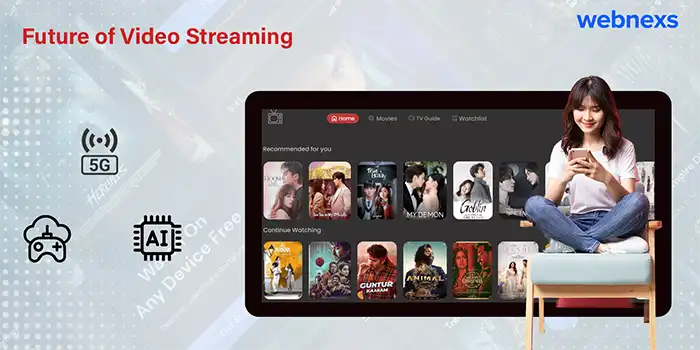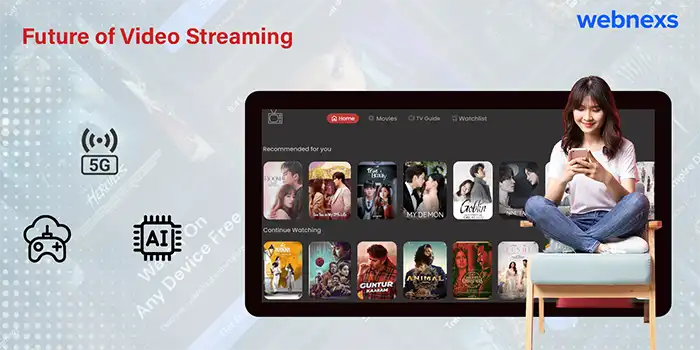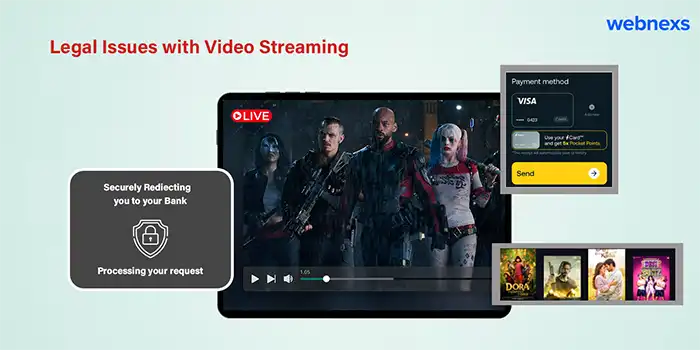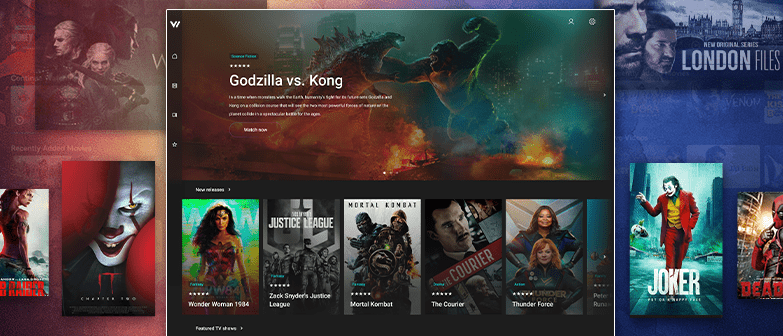In today’s digital age, video streaming has become an essential part of our lives. Video streaming technology has revolutionized the way we consume media and entertainment, and it has become increasingly important for businesses to incorporate video streaming into their marketing strategies. In this article, we will explore the what is video streaming, its advantages, technical aspects, types, protocols, codecs, bandwidth, popular video services, devices, emerging technologies, legal issues, and pros and cons.
Explanation of Video Streaming
Video streaming is transmitting video content over the internet in real-time. It allows users to watch videos without downloading them. It enables users to access a vast array of content, from movies and TV shows to live events and educational videos. It has become a preferred way of consuming media because it offers a more flexible and personalized experience compared to traditional broadcasting.
Importance of Video Streaming in Today’s Digital Age
The importance of video streaming in today’s digital age cannot be overstated. It has become a primary source of entertainment and education for people all over the world. Here are some video streaming statistics:
- As of 2021, the global video streaming market was valued at $50.11 billion USD, and it is expected to reach $184.3 billion USD by 2027.
- Netflix is the most popular video streaming service worldwide, with over 200 million subscribers.
- YouTube is the most popular video streaming service in the United States, with over 120 million unique monthly visitors.
- In 2020, 68% of all internet users in the United States watched streaming video content, and the average viewer watched 8.8 hours of content per week.
- The COVID-19 pandemic caused a surge in video streaming, with global streaming hours increasing by 20% in March 2020.
- In 2020, Disney+ became the fastest-growing streaming service, reaching 50 million subscribers in just five months.
- Mobile video streaming is becoming increasingly popular, with 52% of global video streaming now taking place on mobile devices.
- The top three reasons people subscribe to video streaming services are: the ability to watch content on demand, access to exclusive content, and the ability to watch content without ads.
- The video streaming industry is expected to continue growing rapidly, with new technologies like 5G and virtual reality creating new opportunities for streaming providers.
- According to a survey by Hub Entertainment Research, 65% of consumers say they are willing to pay for a streaming service that offers early access to movies that would have otherwise been released in theaters.
Brief History of Video Streaming Technology
Video streaming technology has come a long way since its inception in the 1990s. The first video streaming service, RealPlayer, was launched in 1995. However, it was not until the mid-2000s that video streaming became popular, thanks to the widespread availability of broadband internet. Today, video streaming is an integral part of our daily lives, with numerous streaming services and devices available.
What is Video Streaming?
Video streaming is the process of delivering video content over the internet in real-time. It allows users to watch videos without downloading them. Video streaming is different from traditional broadcasting because it is delivered over the internet instead of through a radio frequency or satellite signal.
Difference Between Video Streaming and Traditional Broadcasting

Traditional broadcasting involves transmitting a radio frequency or satellite signal to a receiver that then decodes the signal into audio and video. In contrast, video streaming delivers content over the internet in real-time. It allows users to watch videos on-demand and offers a more flexible and personalized experience compared to traditional broadcasting.
Advantages of Video Streaming
Video streaming has several advantages over traditional broadcasting, including:
- Convenience: Users can watch videos on-demand at their convenience, without being tied to a broadcast schedule.
- Flexibility: Video streaming allows users to watch videos on a variety of devices, including smartphones, tablets, and smart TVs.
- Personalization: Video streaming services offer personalized recommendations based on users’ viewing history and preferences.
- Cost-effectiveness: Video streaming is often more cost-effective than traditional cable or satellite TV subscriptions.
- Global access: Video streaming allows users to access content from anywhere in the world, as long as they have an internet connection.
How Does Video Streaming Work?
Video streaming is a method of delivering video content over the internet in real-time. The process of video streaming involves breaking down the video into small segments and transmitting them over the internet as a continuous stream of data. They sent the stream of data to a device, such as a smartphone or computer, that can decode the data and display it on a screen in real-time.
The video streaming process typically involves three main components: the video source, the encoding software, and the delivery network. The video source can be a live event or a pre-recorded video file. The encoding software compresses the video file into a format that can be easily transmitted over the internet. The delivery network transmits the data to the end user’s device.
When a user clicks on a video to watch, the video player on their device sends a request to the video source for the video file. The video source then sends the video file to the encoding software, which compresses the video into a format suitable for streaming. They then sent the compressed video to the delivery network, which breaks the video into small data packets and sends them to the user’s device in real-time.
The user’s device receives the data packets and uses a video player to decode the data and display it on the screen. The video player reconstructs the video stream from the data packets and displays it on the screen in real-time. The video player also buffers some data to ensure that the video stream plays smoothly without interruptions.
It works by breaking down the video into small data packets and transmitting them over the internet in real-time. The video player on the user’s device decodes the data packets and displays the video stream on the screen in real-time. This allows users to watch video content on-demand, without having to download the entire video file before watching it.
Video streaming involves several technical components, including:
- Encoder: The encoder converts the video into a digital format that can be streamed over the internet.
- Server: The server hosts the video content and delivers it to users over the internet.
- Content delivery network (CDN): The CDN is a network of servers that distribute the video content to users around the world.
- Player: The player is the software that plays the video on the user’s device.
Read More: What is video transcoding and why it is important in streaming business
Video Streaming Protocols
Video streaming protocols are the rules and standards that govern the transmission of video data over the internet. There are several different video streaming protocols, each with its own advantages and disadvantages.
Some of the most popular video streaming protocols
HTTP, RTMP, HLS, and MPEG-DASH. HTTP (Hypertext Transfer Protocol) is the standard protocol used for web browsing, and it is commonly used for streaming video over the internet.
RTMP (Real-Time Messaging Protocol) is a proprietary protocol
developed by Adobe for streaming audio, video, and data over the internet.
HLS (HTTP Live Streaming) is an adaptive streaming protocol developed by Apple for streaming video content to iOS devices.
MPEG-DASH (Dynamic Adaptive Streaming over HTTP) is an open standard developed by the Moving Picture Experts Group (MPEG) for streaming multimedia content over the internet.
When it comes to choosing a video streaming protocol, there are several factors to consider, including the quality of the content, the reliability of the connection, and the compatibility of the protocol with the device being used to stream the content.
What are video codecs?
Video codecs are software or hardware tools used to compress and decompress digital video. They are used to reduce the file size of video content, making it easier to store and transmit over the internet. Codecs can either be lossless or lossy. Lossless codecs compress the video losing no quality, while lossy codecs sacrifice some quality in order to achieve greater compression.
Types of video codecs
There are many types of video codecs available, each with its own strengths and weaknesses. Some popular video codecs include:
- H.264/AVC: This codec is widely used and supported by most devices and browsers. It offers good compression and video quality, making it a popular choice for streaming services.
- H.265/HEVC: This codec is an improvement over H.264 and offers better compression, which means smaller file sizes for the same video quality. However, it requires more processing power to encode and decode.
- VP9: Developed by Google, VP9 is an open-source codec that offers good compression and video quality. It is widely supported by browsers, but less so by devices.
- AV1: Another open-source codec, AV1 offers even better compression and video quality than VP9. However, it requires significant processing power and is not yet widely supported by devices.
Popular Video Streaming Services:

There are several popular video streaming services available today, offering a wide range of content to viewers. Here are three of the most popular ones:
Netflix:
Netflix is a subscription-based streaming service that offers a vast selection of TV shows, movies, documentaries, and original content. It has gained immense popularity due to its affordable monthly subscription plans and a wide range of content available in different languages.
Amazon Prime Video:
Amazon Prime Video is another popular streaming service that is part of Amazon Prime membership. It offers a broad selection of TV shows, movies, and original content. Amazon Prime Video is well-known for its exclusive access to popular shows like The Marvelous Mrs. Maisel, The Boys, and Tom Clancy’s Jack Ryan.
Hulu:
Hulu is a subscription-based streaming service that primarily offers TV shows from popular networks like ABC, NBC, and FOX. It also offers a selection of movies, documentaries, and original content. One of the unique features of Hulu is its ability to stream current TV shows shortly after they air on cable networks.
Other popular streaming services include Disney+, HBO Max, Apple TV+, and YouTube TV.
Video Streaming Devices:
Video streaming devices are hardware devices that allow users to stream video content from various sources to their TV or other display devices. There are various types of video streaming devices, including:
- Streaming sticks: These are small devices that plug into the HDMI port of a TV and are powered by a USB cable. Popular examples include Amazon Fire TV Stick, Roku Streaming Stick, and Google Chromecast.
- Set-top boxes: These devices are similar to streaming sticks, but they are larger and offer more advanced features. They usually come with a remote control and can be connected to the internet via Wi-Fi or Ethernet. Popular examples include Amazon Fire TV, Apple TV, and Nvidia Shield TV.
- Smart TVs: These are TVs that come with built-in streaming capabilities, so there is no need for a separate streaming device. Many popular brands offer smart TVs, including Samsung, LG, and Sony.
- Gaming consoles: Many gaming consoles, such as PlayStation and Xbox, also offer streaming capabilities and can be used to access various streaming services.
Future of Video Streaming:

The future of video streaming looks promising, with the constant evolution of technology and the increasing demand for high-quality content. Here are some emerging technologies in video streaming:
5G Network:
With introducing 5G network, users can experience faster download and streaming speeds, higher quality videos, and reduced latency. This will enable seamless streaming of high-resolution content on mobile devices.
Cloud Gaming:
Cloud gaming services like Google Stadia and Microsoft xCloud are already gaining popularity. This technology allows users to play high-end games on low-end devices as the game is rendered on cloud servers and streamed to the user’s device
Virtual Reality:
Virtual reality (VR) is becoming more accessible to the masses, and streaming platforms are starting to offer VR experiences. This technology offers an immersive experience to users, making them feel like they are part of the content.
Artificial Intelligence:
AI is being integrated into video streaming services to offer personalized recommendations to users. This will enhance the user experience and ensure that users only receive content that is relevant to them.
Predictions for the future of video streaming include:

Increased competition:
As more players enter the market, there will be increased competition for content and viewership. Streaming services will need to differentiate themselves by offering unique content and user experiences.
Consolidation:
The streaming industry may see consolidation as smaller players merge or are acquired by larger companies.
Diversification of Content:
Streaming services will continue to offer a variety of content, including original programming, live sports, and news, to attract and retain users.
More Interactivity:
Streaming services will continue to integrate interactive features to engage users and make the experience more immersive. This may include virtual watch parties and live interactive events.
Overall, the future of video streaming looks bright, with new technologies and innovations making it easier for users to access high-quality content anytime, anywhere.
Legal Issues with Video Streaming:

Legal issues with video streaming can arise from several factors, including copyright infringement, piracy, and the use of illegal streaming services.
Copyright infringement
When someone streams or downloads copyrighted content without the owner’s permission. This includes movies, TV shows, music, and other copyrighted materials. Many video streaming services have strict policies in place to prevent copyright infringement, and they take action against users who violate these policies.
Piracy
It occurs when someone streams or downloads copyrighted content without the owner’s permission and then distributes it illegally. Piracy can cause significant financial losses for content creators and distributors, and it is illegal in most countries.
Illegal streaming services are another problem for the video streaming industry.
These services offer access to copyrighted content without the owner’s permission and often charge a fee for this access. Illegal streaming services can be difficult to shut down, and they can cause significant financial losses for content creators and distributors.
Read More: What is DRM? How to choose the right one?
To avoid legal issues with video streaming, it is important to use only legal streaming services and to respect copyright laws. This means paying for content and using only services that have the necessary licenses and permissions to distribute it. It is also important to be aware of the risks of using illegal streaming services, which can expose users to malware, viruses, and other security threats.
Advantages of video streaming:
- Convenience: Users can stream content anytime and anywhere without the need for physical media.
- Personalization: Streaming services offer personalized recommendations based on users’ viewing history and preferences.
- Flexibility: Users can easily switch between different streaming services and upgrade their devices.
- Cost-effective: Streaming services are generally cheaper than cable or satellite TV subscriptions.
Disadvantages of video streaming:
- Dependence on internet connectivity: Video streaming requires a stable and fast internet connection. But today every corner of world has got fast internet and this is no more a disadvantage in the cities where people spend a lot of money.
- Quality may be affected by bandwidth limitations: slow internet speeds or data caps may compromise Streaming quality.
- Content rotation: Some streaming services rotate their content regularly, meaning users may not have access to their favorite shows and movies permanently.
- Legal issues with piracy and copyright infringement.
Conclusion:
Video streaming has revolutionized the way people consume content, providing more convenience and flexibility than traditional TV subscriptions. Popular streaming services like Netflix, Amazon Prime Video, and Hulu offer a wide variety of content and personalized recommendations. Smart TVs and streaming devices provide more options for users to access streaming services. However, legal issues with piracy and copyright infringement continue to be a challenge for the industry. Overall, the future of video streaming looks bright with emerging technologies and increasing investment in original content production.
Frequently Asked Questions(FAQ)
1. What is video streaming?
Video streaming is a technology that allows users to watch video content in real-time over the internet without having to download the entire file before viewing it.
2. How does video streaming work?
Video streaming works by breaking the video content into small chunks of data that can be transmitted over the internet in real-time. The video player buffers these chunks of data and plays them in sequence to create a smooth and uninterrupted viewing experience.
3. What are the different types of video streaming?
There are two main types of video streaming: live streaming and on-demand streaming. Live streaming allows users to watch video content in real-time as it is being broadcasted over the internet, while on-demand streaming allows users to watch pre-recorded video content at their convenience.
4. What are the requirements for video streaming?
To stream video content, users need a stable internet connection, a device with a compatible web browser or app, and sufficient bandwidth to receive the video data in real-time.
5. What are some popular video streaming services?
Some of the most popular video streaming services include Netflix, Hulu, Amazon Prime Video, Disney+, and YouTube. These services offer a wide variety of video content, including movies, TV shows, and original programming.


